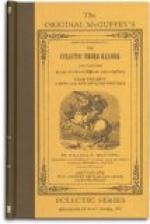Remark I.—In this table, the short sounds are nearly or quite the same, in quantity, as the long sounds. The difference consists chiefly in quality. Let the pupil determine this fact by experiment.
Remark ii.—The vocals are often represented by other letters or combinations of letters than those used in the table: for instance, a is represented by ai as in hail, by ea as in steak, etc.
Remark iii.—As a general rule, the long vocals and the diphthongs should be articulated with full, clear utterance; but the short vocals have a sharp, distinct, and almost explosive utterance. Weakness of speech follows a failure to observe the first point, while drawling results from carelessness with respect to the second.
SUBVOCALS AND ASPIRATES (13)
Subvocals are those sounds in which the vocalized breath is more or less obstructed.
Aspirates consist of breath only, modified by the vocal organs.
Words ending with subvocal sounds may be selected for practice on the subvocals; words beginning or ending with aspirate sounds may be used for practice on aspirates. Pronounce these words forcibly and distinctly, several times in succession; then drop the other sounds, and repeat the subvocals and aspirates alone. Let the class repeat the words and elements, at first, in concert; then separately.
TABLE OF SUBVOCALS AND ASPIRATES. (14)
Subvocals. as in
b babe d bad g nag j judge v move th with z buzz z azure (azh-) w wine
Aspirates. as in
p rap t at k book ch rich f life th smith s hiss sh rush wh what
Remark.—These eighteen sounds make nine pairs of cognates. In articulating the aspirates, the vocal organs are put in the position required in the articulation of the corresponding subvocals; but the breath is expelled with some force, without the utterance of any vocal sound. The pupil should first verify this by experiment, and then practice on these cognates.
The following subvocals and aspirate have no cognates:
Subvocal as in
l mill ng sing m rim r rule n run y yet
ASPIRATE.
h, as in hat.
SUBSTITUTES. (14)
Substitutes are characters used to represent sounds ordinarily represented by other characters.
Table of substitutes.
Sub for as in




